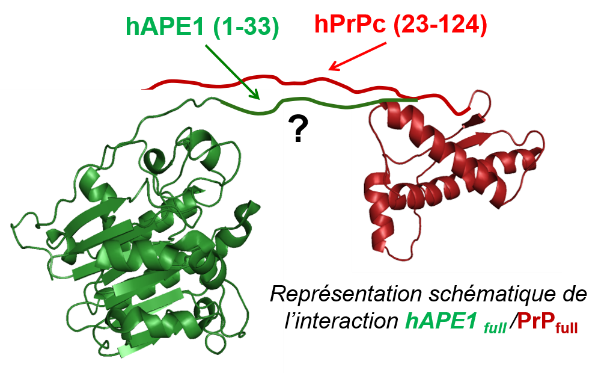- Imprimer
- Partager
- Partager sur Facebook
- Partager sur X
- Partager sur LinkedIn
Specific recognition of DNA:
 Specific recognition of DNA by peptide zinc-finger
Specific recognition of DNA by peptide zinc-finger
The design of specific probes targeting precise DNA sequences is of particular interest for understanding the mechanism of genes expressions or interfering with it. In an ongoing project (O. Sénèque –CEA Grenoble – ANR RecoDNA) synthetic zing-finger peptide are designed as luminescent or photo-damaging probes to target specific DNA sequence of at least 12 to 18 nucleotides long. Such sequences are expected to be unique in a eukaryotic genome and thus could be used for medical diagnosis or phototherapy. Our objectives are to highlight and characterize in details the DNA/peptide interactions to give clues on how to modulate and improve the probes efficiency.
DNA Repair:
Cellular DNA is permanently attacked by endogenous and exogenous agents leading to the formation of numerous types of lesions (modified bases, abasic sites, strand breaks, etc...) that are managed by specific repair pathways but that can be highly mutagenic or even lethal if not repaired.
We are mainly studying proteins involved in BER, which is specific pathway for modified bases and abasic lesions.We determine in details their activity using enzymatic assays or their interactions using biophysical technics. We use also NMR to determine their structural features (see DNA and protein structural studies by NMR). Our expertise in molecular biology enables us to produce the proteins (wild type, mutants, truncated) and label them with isotopes for NMR structure or with fluorophores for interaction studies.
For more info: J.Mol Biol 2014 ; AIMS Materials Science 2015 ; Biochemistry 2016
Protein/protein interactions:

Specific protein–protein interactions are involved in many molecular processes within a cell. The study of the protein interactome is of the utmost importance as it empower the current knowledge on biochemical cascades, as well as the discovery of putative protein targets of therapeutic interest. We focus our research on understanding these protein/protein interactions (structural, thermodynamic, kinetic point of view).
Our ongoing research focuses on the understanding of some beneficial roles of the human prion protein hPrp . While its physiological role in the cells is still poorly understood, a recent study demonstrated its protective effect of neuronal cells exposed to genotoxic agents by stimulating DNA repair and more precisely hAPE1 a major repair enzyme. This stimulation requires the binding of the N termini of hPrP and hAPE1.
Another project aims at characterizing the structure of a protein complex involved in the coagulation process and to search for new oral coagulants to treat hemophilia patients.
Recent collaborations:
P. Radicella (CEA, Fontenay aux Roses)
A.Thomas (DPM, Grenoble) – J. Marquez (EMBL, Grenoble)
Project Staff
- Imprimer
- Partager
- Partager sur Facebook
- Partager sur X
- Partager sur LinkedIn